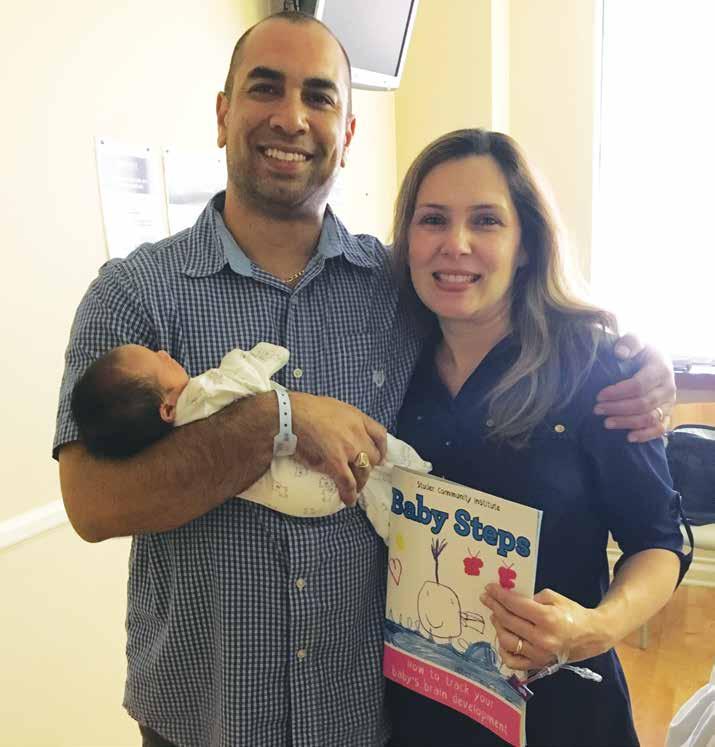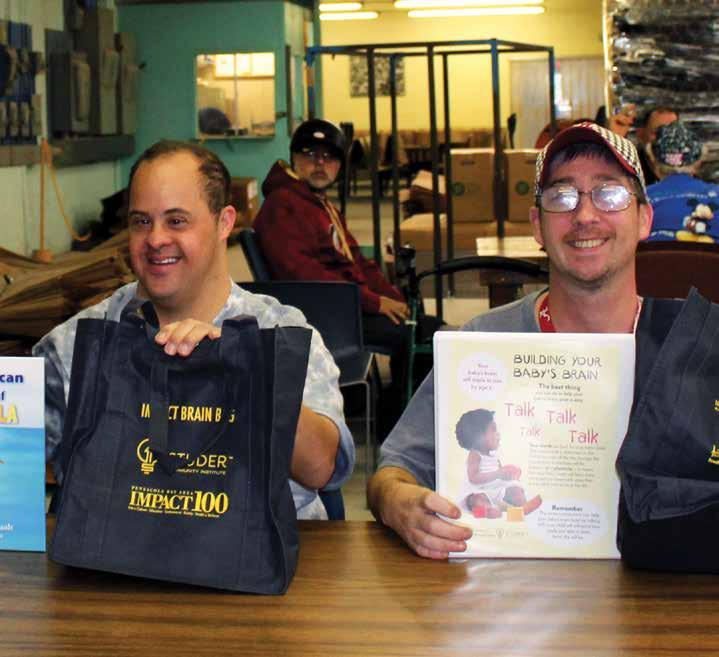
6 minute read
BRAIN BAG UPDATE
SPREADING the ofEarly TalkMESSAGE THROUGH HEALTHCARE SYSTEMS
The message is spreading.
Advertisement
As the Brain Bag project continues to educate local parents about the important role that parent talk and interaction plays in healthy early brain development, the project’s concept is gaining traction in other communities.
Studer Community Institute has partnered with two hospital systems — one in Cincinnati and one in Laurinburg, N.C., — to help them bring the Brain Bag concept to their communities.
The regional footprint of the project is growing, too.
Beginning in 2020, these early literacy gift bags will be handed out to mothers at Santa Rosa Medical Center in Milton, thanks to publisher Sandi Kemp and the sponsorship of The Navarre Press’ Newspapers In Education program.
Adding these mothers to the roughly 5,000 women who deliver babies at Escambia County’s three birthing hospitals will mean that nearly 5,350 families each year will get a gift that we hope will start them on a lifelong journey of learning.
“My wife just mentioned to someone that new babies, in fact, now DO come with instructions!” said Pensacola dad Jay Brown, whose daughter, Lucy, was born in August 2019 at Sacred Heart Hospital. “The Brain Bag was such a nice thing to receive. I'm looking forward to reading ‘P is for Pelican’ when Lucy is a tad older, too. “Thankfully my wife, a former librarian, is already a big believer in reading to kids and the value of vocabulary, but I think your organization has great a mission and is doing wonderful things to that point.” BY Shannon Nickinson STUDER COMMUNITY INSTITUTE
They are given free of charge to every parent whose child is born in Baptist, Sacred Heart and West Florida hospitals, because every parent will benefit from the message that talk and interaction is a key ingredient to healthy early brain development and ultimately school readiness.
The Bags are given with a lesson in the hospital reviewing what’s inside and sharing with parents key points about why parent talk is so critical to a child’s development — and ultimately school readiness. Those key points include: • 85 percent of your baby’s brain is built by age 3. The best thing you can do to help your baby’s brain grow is easy — Talk! • Your words are food for your baby’s brain. The more words a child hears in
the first three years of life, the stronger the connections in his brain will be. Experts call it plasticity — it means that your baby’s brain will learn more, more easily in these years than at any other time in his life. • Your baby’s school readiness starts today. How strong the foundation of your child’s brain development is, how many connections you help his brain build by talking with him, will influence how ready and able to learn he will be for the rest of his life.
The Brain Bag survey also asks moms two questions: On a scale of 1-10, rate your knowledge of how parent talk influences early brain development before the Brain Bag, and then rate it after. Here is how the responses breakdown by hospital for fall of 2019: • West Florida: 6.7 to 9.6 • Baptist: 8.2 to 9.7 • Sacred Heart: 7.9 to 9.7 • Overall cumulative: 7.6 to 9.7
North Carolina, Ohio building on program TriHealth is Cincinnati’s largest provider of maternity and general pediatric services. That positions them well to lead the Early Learning City effort in Cincinnati, said Emily Harmeling, project manager for primary care and pediatrics.
She said that they began educating patients on early learning concepts and distributing Brain Bags in August 2019.
“In the first year, we will provide education and Brain Bags to an estimated 10,000 families post-delivery at three hospitals, representing 36% of the deliveries in the Cincinnati market,” she said. TriHealth Pediatric and Family Medicine providers are also incorporating Early Learning City communication in their touchpoints during patients’ first years of life. In year one, the project will provide Brain Bags to an estimated 6,000 families with children up to 18 months old in 14 pediatric practices and 19 family medicine practices across the city, Harmeling said.
Pam Coyle-Toerner, executive director at TriHealth, says her team is “thrilled to lead Cincinnati in becoming an Early Learning City, and we are grateful for the guidance of our partners at Studer Community Institute. During our visit to Pensacola, SCI’s early learning efforts were evident throughout the city, and the impact was undeniable,” Coyle-Toerner said. “Cincinnati’s kindergarten readiness rates are comparable to those in Pensacola, and like SCI, we know we can do better for the children in our community.”

Pediatrician Joe Bailey is medical director at TriHealth. He was excited to bring the concept to pediatric wellbaby visits.
“What’s appealing about the Early Learning City concept is that we can offer parents a way to improve their child’s chance at success at no cost to the parent, other than their loving words,” Bailey said.
“Our clinicians are excited to build on SCI’s work in healthcare by continuing early brain development education beyond the hospital in our primary care practices, where we see each child for 11 well visits before they turn three. Every touch point is an opportunity for us to teach parents about the power language has on their baby’s growing brain.”
Starting in September 2019, Scotland Health System in Laurinburg, N.C., joined the project, using the bags and a video lesson to reach and teach parents. “Within Scotland County and North Carolina in general, our average readiness for children entering kindergarten is below the national average, and we are very excited to be able to contribute the needed tools and education to new parents about the importance of the early development of a child’s brain,” said Lisa Hunt, director of community health.
In Scotland County, the kindergarten readiness rate is 47 percent, compared to the state rate of 50 percent.
In the first month since the project launched there, Michelle Herberg, director of women’s services, said the staff has embraced it — and patients are responding. Scotland has about 725 births a year.
“Patients have loved it and they love getting their first book from us,” Herberg said. “It’s part of the patient education process now, so the staff is used to giving them out. The video has worked very well into the workflow.”
The next step, Herberg said, is to coordinate with partners in the community,

including the health department, to reinforce the message that early parent interaction is a vital force in a child’s healthy development — and school readiness.
Arc Gateway’s Pollack Industries stores, assembles and ships the bags to Scotland Health, an extension of the work Arc already does with the local Brain Bag project.
“Our staff is looking forward to being able to say they helped make a difference in every child who is born within our Women’s Center,” Herberg said.
WHAT IS A BRAIN BAG? Each year, 5,000 women give birth in the three birthing hospitals in Escambia County. Each of those women now leave the hospital with an important tool to help them give their child a good start in life — a Brain Bag.
Brain Bags are early literacy gift bags given to mothers before they leave the hospital. They include: → A storybook, “P is For Pelican, the ABCs of Pensacola,” which uses landmarks in our community to build letter awareness and encourage family reading. → Baby Steps, a baby book that can be personalized to help parents track early brain development milestones in the first three years of life. → A toy. → Community resource information from partners to help support parents. It includes library locations, screen time guidelines, healthy lifestyle advice for the first year of life and more. They also include a video lesson, produced by SCI, to help reinforce the important message that talking, reading, singing and playing with children from the very first days of life is critical for early brain development.
The Brain Bags are stored, assembled and delivered by Arc Gateway’s Pollak Industries, which offers life- and work-skills training for adults with developmental disabilities.










